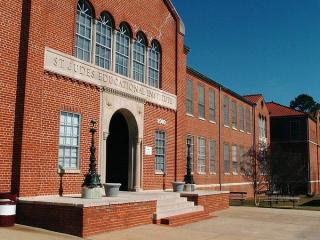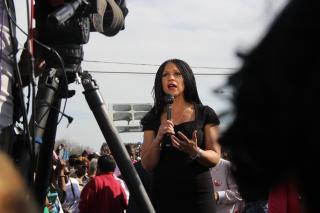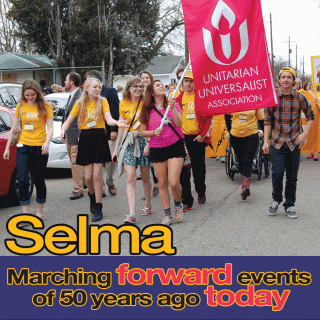"Tracing Their Steps" – Reflections from Selma Pt. 4
By Bart Frost
Marching Forward Events of 50 Years Ago Today
This is the final installment in a series of reflections on the 50th Anniversary of the Selma Marches. Here are Part One, Part Two, and Part Three. – ed. Sunday was the day that most of us were waiting for, the anniversary of the bridge crossing. An opportunity to follow the footsteps of those who came before.Before we could cross the bridge, we had to get there first. After gathering on to the buses and heading out in the morning, we landed at City of St. Jude in Montgomery for lunch. During the Selma to Montgomery Marches in 1965 more than 20,000 people camped out on the campus of the City of St. Jude, which was originally opened as a educational institute with college prep and trade programs for African-Americans in Montgomery. It was also the first integrated hospital in the Southeast and where eldest two children of Martin Luther and Coretta Scott King were born. After a traditional southern lunch with a small worship with more singing from Kim and Reggie Harris with Brother Sun, we headed back out on to the road.
Selma is 60 miles of highway from Montgomery, and in 1965 about 300 people marched ten miles a day from Selma to Montgomery for the right to vote. Supporters, activists, and other volunteers drove supplies to the marchers and brought people from Selma to Montgomery. One of those allies was Viola Liuzzo, a Unitarian Universalist mother from Detroit, who was driving a carload of activists from Selma to Montgomery when a car filled with members of the KKK chased them, pulled alongside them, and shot her. As we approached her memorial on Highway 80, our bus slowed down and the Rev. Jeanne Pupke led us in singing "Spirit of Life" as we drove past the memorial.
Spirit of Life, come unto me. Sing in my heart all the stirrings of compassion. Blow in the wind, rise in the sea; Move in the hand, giving life the shape of justice. Roots hold me close; wings set me free; Spirit of Life, come to me, Come to me.
As we sang, I felt tears sting my eyes. Here is the spot where someone was murdered because they believed that all people should have the right to vote and to be treated fairly and equally. Here a group of men were so full of hate and fear that they shot a mother of five dead. How many men filled with anger and hate beat or killed elders with grandchildren, fathers and mothers, sons and daughters to keep them down? How many continue to do so knowingly or unknowingly?
Shortly after, we unloaded in a small park in Selma and met with the group of UUs that already assembled. After a prayer – reminding us why we were first called to Selma and why we were there again – and song, we marched. We were led at the head of the column by the youth who attended the Selma Living Legacy Project conference. We were not led by the future embodiment of our faith, but by the current embodiment. Some of the clergy called to Selma in 1965 were not much older than the youth carrying the Unitarian Universalist Association banner, and were the same age as the seminarians that were assisting in supporting the youth.
As we marched through Selma, I recognized something familiar. Selma felt almost like New Orleans during Carnival. Shotgun houses, and matriarchs and patriarchs sitting on the porch with children playing in the yard or on the street as the middle generations grilled and laughed. Shouts familiar to anyone who has walked a parade route or been tothe Sunday closest to Super Sunday ("We've got chicken! Hot dogs! Burgers! Water's a dollar!") were accompanied by delicious smells that are unique to entrepreneurial home cooks.
As we got closer to the town center and the Edmund Pettus Bridge, I spent the last of my cash on two bottles of water after realizing I didn't bring any for the youth. In the town square, there were more than 50,000 people waiting to cross or coming back from crossing. Melissa Harris Perry broadcast live from Selma on a raised stage with the bridge behind her. We were carried along with the crowd toward the historic Pettus Bridge, and (as most folks who have taken youth or their children to a large event) it was had to remember where I was or why this moment was important to me personally. To be honest, what I most wanted was for all of the youth to cross that bridge together and losing one of them was a huge fear.
Once past the apex of the bridge the crowds disappeared. I looked back and saw the youth with the bridge behind them. My inner time-machine took me back 50 years. 50 years ago, if we were with the marchers on Bloody Sunday there would be a posse of uniformed police and white men wearing their hate on their faces. There were dogs, bats, and billy clubs. Today, there was a stage and more food vendors. Where did the marchers get the courage to stare down the face of hate, even for a moment, knowing that their lives were on the line? How would I have faced the possibility of permanent injury or death? At one point of my life, I'm sure I would have. But today, at the age of 28, I'm not so sure anymore, and yet my friends and family could be shot tomorrow by a police officer who sees the color of their skin instead of their humanity. As the youth reflected on the occasion, I wondered to myself "How can I support my friends and family when I am stricken through with fear?" How can I support their courage and work?
Then one of the youth handed me one of the water bottles empty. "Thanks for grabbing the water, Bart," I heard, "it was hot and we really needed that." Then it hit me. Facing down hate can be as easy as bringing the water and sharing food. Take care of the little things so that other leaders can step up and focus on what's most important. The words of Opal Tometi came back to me, as did those of Kenny Wiley and Hollis Houston. As we gathered back on to the buses, I recommitted myself to supporting the people of color in my life and my communities.
Back at the hotel the youth ate and reflected with the seminarians, creating cross-generational relationships. After dinner I joined the youth for dessert and to hear what they were taking home from this experience. Attending the conference in Selma was important to them for a variety of reasons, for some it was because their peers in school pretend racism doesn't exist or just can't see it. For others it was an opportunity to connect with the past and an inspiration for their future. They all took away a greater understanding of the Unitarian Universalist call to justice and personal commitments to do justice work in their community, no matter how small the action.
They also said they wanted to come back in twenty-five and fifty years, to share their reflections and hear from those who will have taken their place.
Yes, it was a very important weekend, and one that lives on not only because the history, but because of its relevance today. Selma in March 2015 was reminder that the work is not done and will not be done until everyone is free.




